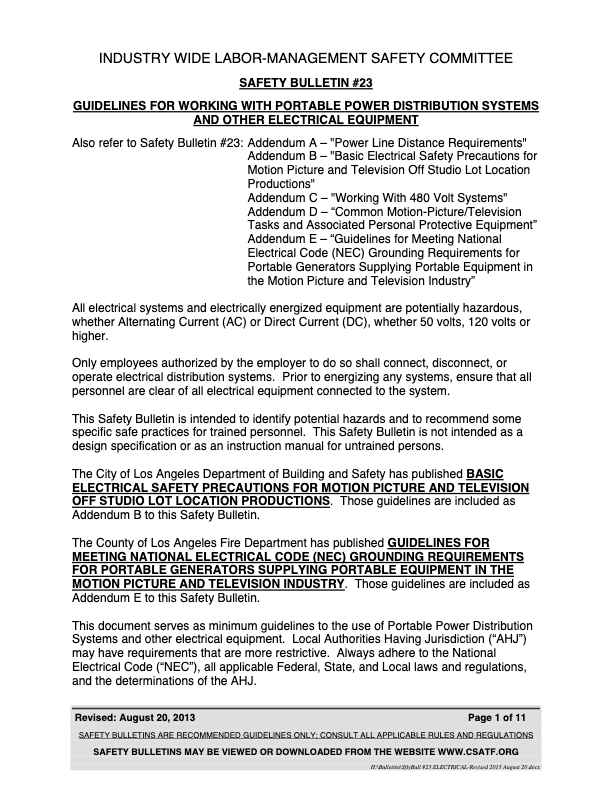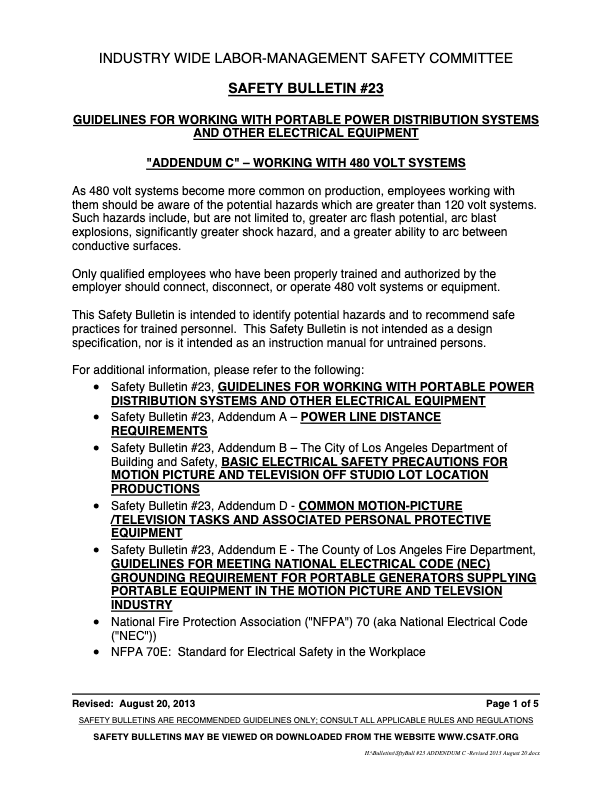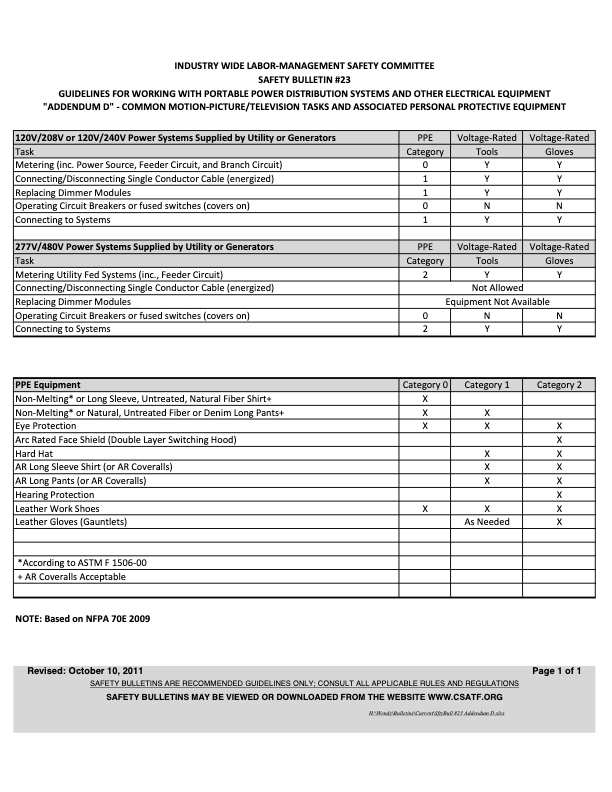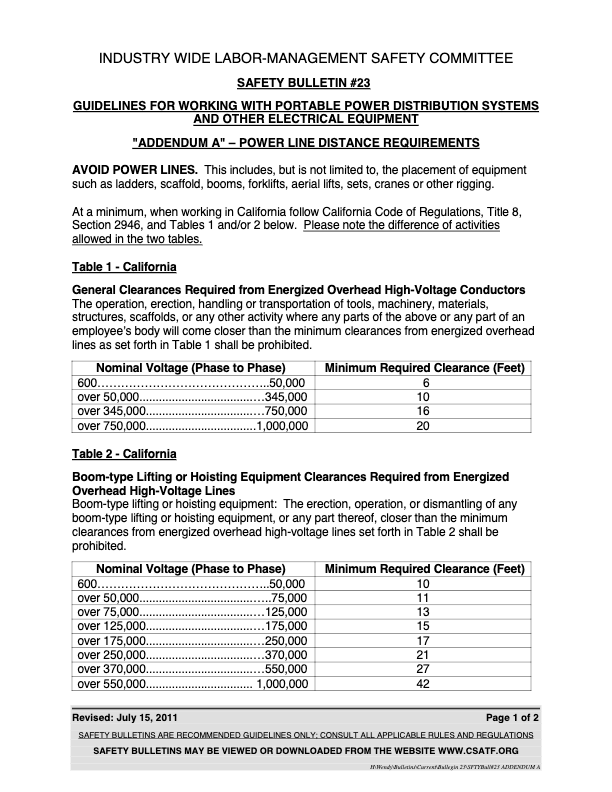Safety Bulletin
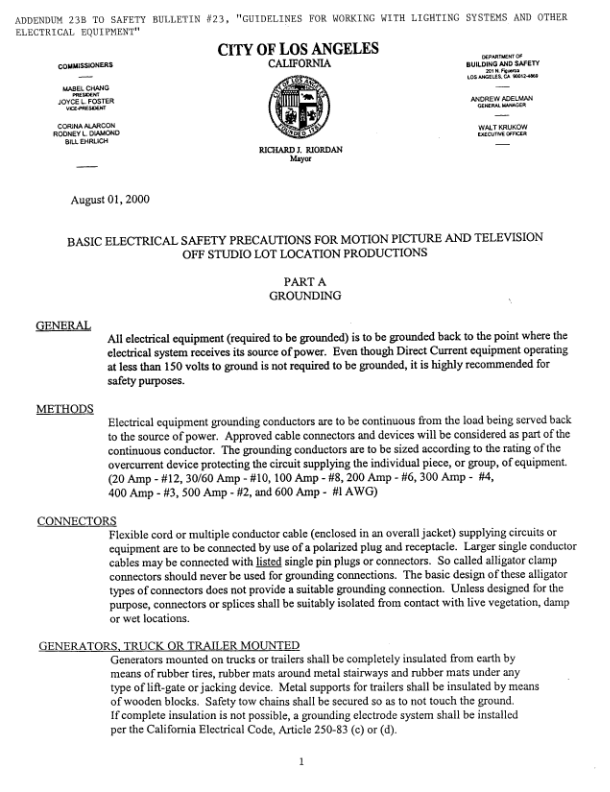
Guidelines
All electrical equipment (required to be grounded) is to be grounded back to the point where the electrical system receives its source of power. Even though Direct Current equipment operating at less than 150 volts to ground is not required to be grounded, it is highly recommended for safety purposes.
Methods
Electrical equipment grounding conductors are to be continuous from the load being served back to the source of power. Approved cable connectors and devices will be considered as part of the continuous conductor. The grounding conductors are to be sized according to the rating of the overcurrent device protecting the circuit supplying the individual piece, or group, of equipment. (20 Amp – #12, 30/60 Amp – #10, 100 Amp – #8, 200 Amp – #6, 300 Amp – #4, 400 Amp – #3, 500 Amp – #2, and 600 Amp – #1 AWG)
Connectors
Flexible cord or multiple conductor cable (enclosed in an overall jacket) supplying circuits or equipment are to be connected by use of a polarized plug and receptacle. Larger single conductor cables may be connected with listed single pin plugs or connectors. So called alligator clamp connectors should never be used for grounding connections. The basic design of these alligator types of connectors does not provide a suitable grounding connection. Unless designed for the purpose, connectors or splices shall be suitably isolated from contact with live vegetation, damp or wet locations.
Generators, Truck or Trailer Mounted
Generators mounted on trucks or trailers shall be completely insulated from earth by means of rubber tires, rubber mats around metal stairways and rubber mats under any type of lift-gate or jacking device. Metal supports for trailers shall be insulated by means of wooden blocks. Safety tow chains shall be secured so as to not touch the ground.
Generator Grounding Connections (when required)
Interior water pipes, interior metal fixtures, metal frames of buildings, and the building grounding electrode system shall not be used as a grounding connection for mobile generators supplying power exclusively to location production systems.
When mobile generators supply power to location production systems in addition to the building’s electrical system, the generator’s grounding connection shall be bonded to the main building grounding electrode system at the service.
Multiple generators shall have their grounding connections bonded to each other when located within 20 feet of each other or when one supplies equipment which might possibly come within 20 feet of equipment supplied by the other(s).
Overcurrent Protection
Conductors and cables should never be loaded in excess of 100% of their actual ampacity. The rating of the overcurrent device (i.e., fuse or circuit breaker) should never be confused with the rating of the conductors or cables.
Rating for Conductors and Cables
The California Electrical Code assigns ampacity ratings for conductors and cables used in motion picture production which are higher than the commonly used ratings. These ratings are found in table 400-5(B), apply only to cable types SC, SCE, SCT, PPE, G and W, and requires that the cable be installed per the footnotes. Ampacities for the commonly used distribution cables are AWG 4/0-360 amps, AWG 2/0-265 amps, AWG #2-170 amps. Note that ampacities listed in column D in the 75 degree C (167 degree F) section are used because 75 degrees C is the maximum rating of termination points.
Rating of Overcorrect Devices
The California Electrical Code requires conductors and cables to be protected by overcurrent devices rated at not more than 400% of the ampacity given in table 400-5(B). Some generators have overcurrent devices rated as high as 1200 amps. Suitable overcurrent devices must be installed to protect the smallest size conductor or cable between the generator and the distribution box (typically AWG #2 “banded” cable).
The 400% rating of the overcurrent device does NOT mean that the cable or conductor may be loaded beyond the ampacity rating given in the table!
Equipment
A branch circuit of any size supplying one or more receptacles shall be permitted to supply stage set lighting loads. A branch circuit is defined as the circuit conductors between the final overcurrent device protecting the circuit and the outlet(s). Twenty amp circuits supply equipment rated up to 2000 watts (16 amps), fifty amp circuits supply 5K’s, hundred amp circuits supply lOK’s. Some equipment is marked with the maximum overcurrent protection permitted.
General Equipment Requirements
All equipment, new and existing, shall comply with the minimum requirements for safety of the Los Angeles Municipal Code. All existing equipment shall be maintained in an electrically safe condition with NO exposed live parts that in any way will present a potential shock or fire hazard.
All equipment shall be provided with overcurrent protection as required by the California Electrical Code. All cables and flexible cords shall be of the types permitted by Articles 400, 520 and 530 of the California Electrical Code and those specifically approved by City of Los Angeles. Welding cable shall not be used.
All Alternating Current (AC) supplied HMI fixtures and ballasts shall be grounded by a continuously connected equipment grounding conductor back to the source of power. These shall not be grounded to the nearest available water pipe connection. This also applies to Direct Current supplied units where grounded. All electrical equipment required to be grounded shall be grounded only by the California Electrical Code required methods and devices.
All electrically powered equipment (except cameras, radios, audio equipment and the like that have self-contained power sources) shall be listed by a laboratory approved by this department. Equipment that does not bear the listing mark of an approved laboratory shall not be used.
General Safety Precautions
Installation Connections and Disconnections
Connections shall be made in the following order:
- Equipment grounding conductor
- Grounded conductor (neutral)
- Ungrounded conductors (hot conductors)
Disconnection shall be in the reverse order.
All connections shall be made from the farthest load connection first, and then progressively toward the source of supply. All disconnections shall be made in the reverse order.
Guarding of Live Parts
In any part of a location distribution system that may potentially have exposed live parts, precautions shall be taken to assure they are covered, shielded, fenced, enclosed, or otherwise protected by means of suitable covers, casings, barriers, rails, screens, mats, or platforms to remove the likelihood of any contact by objects or persons.

